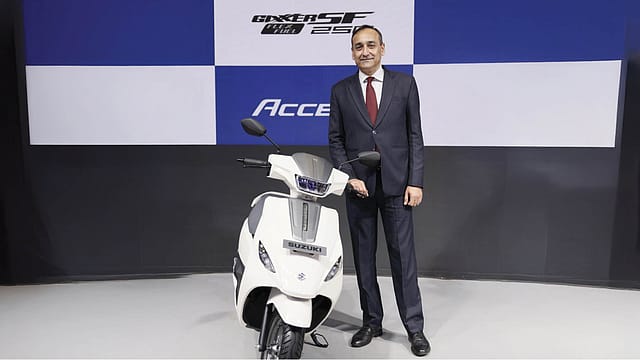As buyers switch to legacy brands, Suzuki Motorcycle says it isn't late to EV race
ADVERTISEMENT

Suzuki Motorcycle India unveiled its first electric scooter—the e-Access—at the Bharat Mobility Global Expo 2025. While the e-scooter is slated to be launched sometime later this year, the two-wheeler maker’s top executive says the company is not late to the EV race.
“We feel we are not late to the EV race because if you see the last three quarters of this financial year, you see customer sentiment switching in favour of legacy brands. So the market is now being driven by legacy brands on the electric side. We see this as a sign of the category getting mature. So I think we are on time,” says Devashish Handa, executive vice-president, (sales, marketing, & after sales), Suzuki Motorcycle India.
Legacy automaker Bajaj Auto overtook Ola Electric to become India’s largest electric vehicle maker in December 2024. TVS Motor Company, too, sold more e-scooters than Ola Electric last month.
Handa says the company’s research shows that the first replacement cycle for electric scooters is in the offing. Those who purchase another EV are likely to go for a “more premium” product than what they had, he says.
Suzuki Motorcycle India, which started operations in 2006, sells about 80,000 units each month. “We have retail demand which can take it up to 1 lakh. We have been expanding capacity but our retail demand has been outstripping that. We look forward to doing more than 1 lakh units by next year by taking capacity enhancement measures,” says Handa.
December 2025
The annual Fortune 500 India list, the definitive compendium of corporate performance, is out. This year, the cumulative revenue of the Fortune 500 India companies has breached $2 trillion for the first time. Plus, find out which are the Best B-schools in India.
The Japanese automaker’s sales mostly come from scooters. “Domestic market is skewed more towards scooters—95% scooters and 5% motorcycles. A large part of that is to do with the fact that commuter motorcycle, which is 50% of the two-wheeler industry and over 75% of the motorcycle industry, is something we have exited,” says Handa.
When asked why the company exited the commuter segment, Handa says Suzuki Motorcycle is known for "higher-value products". “In every evolving market there is a strong trend for upward mobility. That is a better space to be in,” he says. “We would still like to improve this going forward. On the export side, it is not so skewed. 70% of our exports are motorcycles.” About 22% of Suzuki Motorcycles’ total sales come from exports.
The two-wheeler maker plans to double its volumes by 2030. It sold over 12,27,970 units in 2024.
India is the biggest market for Suzuki Motor Corp in terms of two-wheeler volumes, contributing half of its global sales.
